Trine 2 is a physics-driven side-scrolling puzzle platformer that reunites the heroes from the first Trine in a new adventure set in a high fantasy world. After quelling the skeleton invasion in their first quest, the Knight, the Wizard, and the Thief go back to their own lives for a time. They are unexpectedly pulled back together when the titular magical artifact returns, once again entangling their souls into a single physical form. The trio are transported to a jungle teeming with hostile goblins and magically overgrown animals. Using their unique skills to solve puzzles impeding their progress, the heroes traverse thirteen levels. Along the way they encounter two princess sisters whose once-close relationship was fractured by the royal succession, turning their kingdom into the tangled jungle the heroes explore.
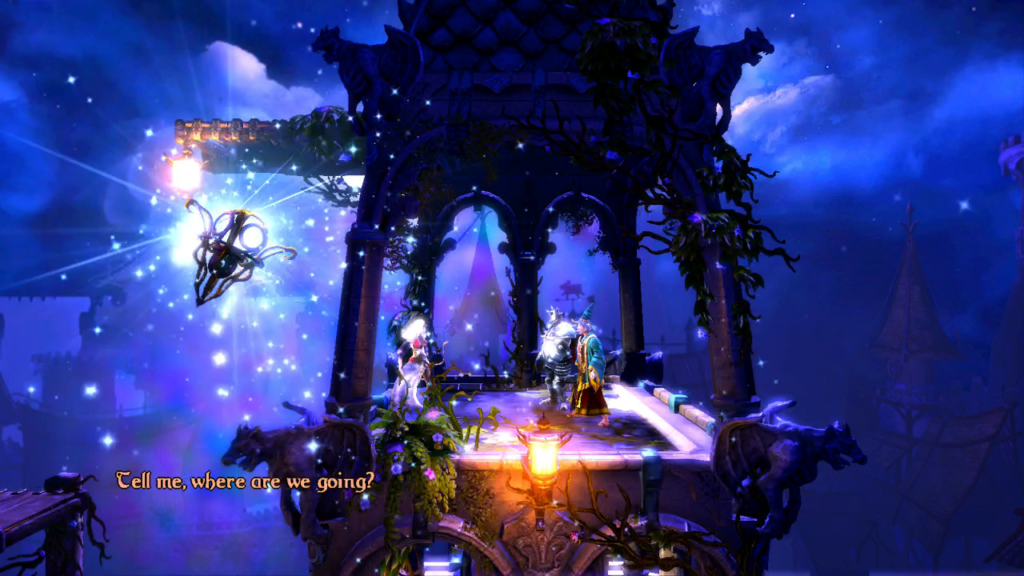
Trine 2 is similar to the first Trine’s Enchanted Edition, the version most widely available on storefronts today and based on Trine 2’s refinements to the engine. Its biggest changes are aesthetic. Instead of generic nameless fantasy classes with stock personalities, each of the heroic trio is given a name and a defined personality. The Knight becomes Pontius, an eager warrior with a naive sense of duty that sends him charging sword-first into every situation. The Thief becomes Zoya, a cynical opportunist used to surviving on society’s fringes which also gives her the trio’s most profound sense of justice. Last, the Wizard becomes Amadeus, a bumbling family man with a demanding wife and children more talented than he who spends more of the adventure worried about getting back home than solving the problem thrust upon them by the Trine.
The main obstacle between the heroes and their goal are large side-scrolling levels filled with platforming scenarios. Unlike in more traditional platformers, where challenge is found through deft maneuvering and precise timing, the platforming here is built on puzzle solving. Each level is divided into discrete challenges where I must stop and examine the environment’s features to determine the best path forward, arranging objects in ways that allow the player characters to leap across a wide gap or open a sealed barrier.
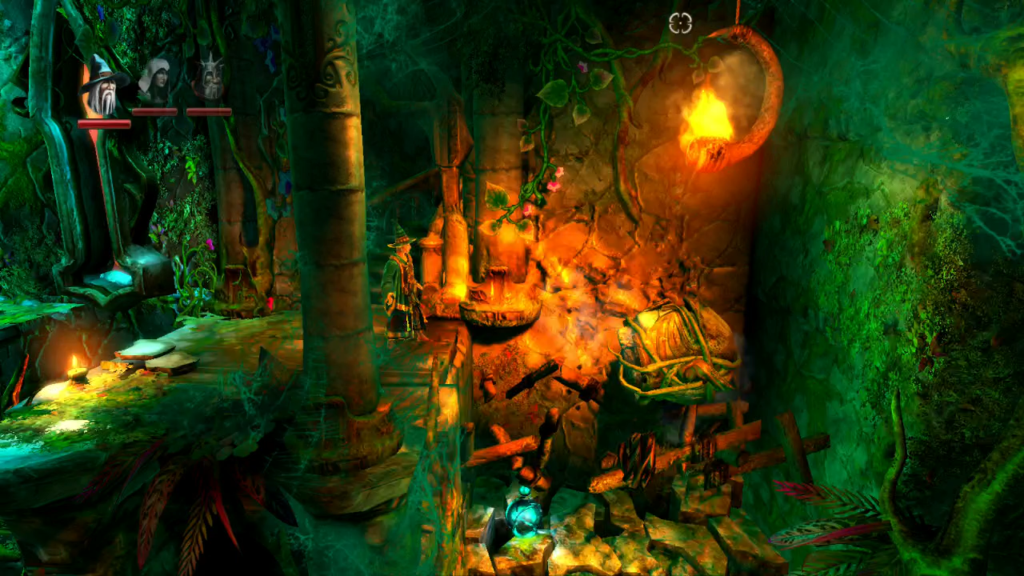
Often, the environment proffers multiple viable paths forward. A simple wooden box can be exploited in several ways. It can be pushed beneath a platform to provide an extra boost up. Wooden boxes float, so it can be moved onto the water to create a new platform from which the player characters can leap. As a third option, a wooden box can be impaled on spikes, nullifying the danger they pose and providing a third optional platform to overcome the current obstacle. If the environment contains enough features and supports the systems to interact with them, viable solutions to a single challenge can be innumerable.
Trine 2 is flavored by its rudimentary physics engine. Characters and objects exist in two states: normal, and super heavy. Goblins and other monsters inhabiting the wild jungle plummet to the floor when they die as though their limbs have become lead. Physics has a more profound effect on platforming than on how monsters move. Many puzzles can only be solved by using heavy objects to crush or smash obstacles. At other times a boulder is more useful for weighing down switches. Because everything is so preternaturally heavy, there are comparatively few puzzles where the solution is to fling an object across the screen. The physics rarely support this solution.
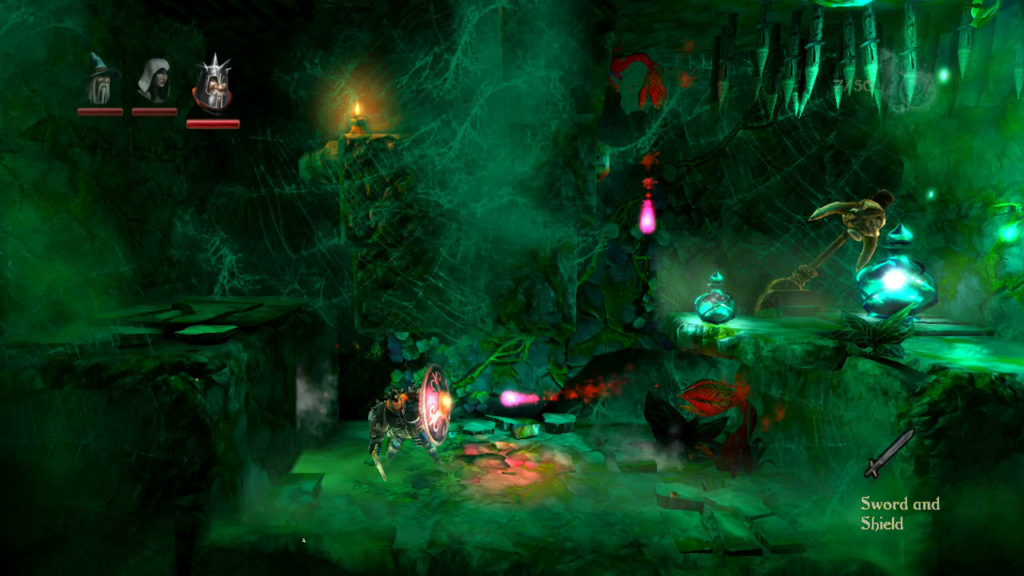
Trine 2 further complicates puzzle platforming with its three distinct player characters. As in the first adventure, the trio are combined by the Trine artifact into a single entity. I can switch between the three at any time using the shoulder buttons, exploiting their individual skills to reach the goal on the far right-hand side of every level.
Pontius is the trio’s fighter. The heroes’ progress is occasionally blocked by a monster pack which must be defeated before the level continues. This is where Pontius shines. Using the right joystick, I can compel him to point his shield in any direction, absorbing most attacks which come his way. He can then counterattack with his elementally empowered sword. The combat is not elegant; I bash the right trigger as many times as I can to make Pontius attack, who obliges by swinging his sword like a five year old with a stick playing pretend. It proves surprisingly effective, cutting through monsters with ease. Only a few powerful varieties require more effort; some goblins are only vulnerable from their backs, forcing Pontius to leap over their heads to reach their vulnerable parts.
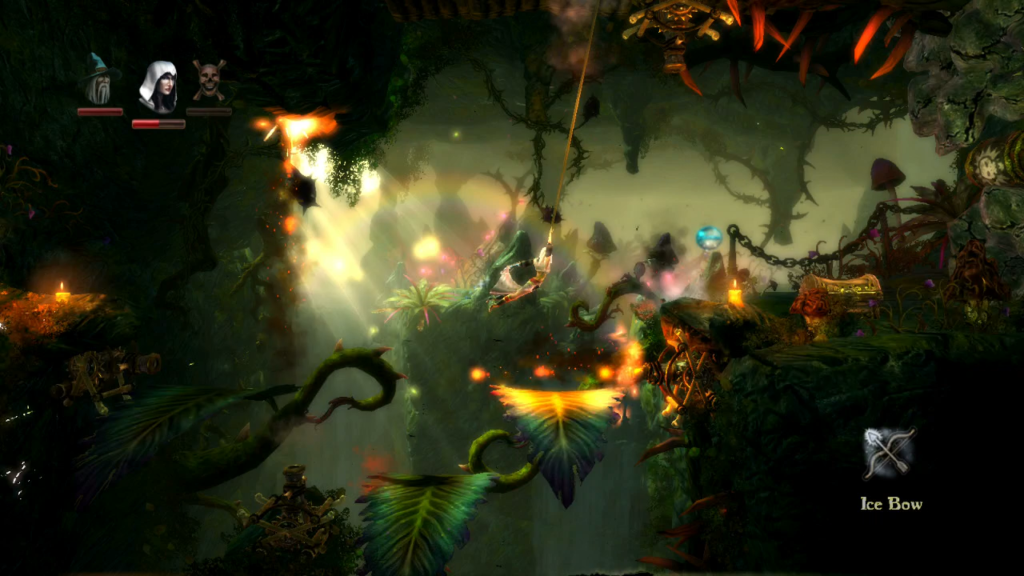
As a thief, Zoya excels at moving through the environment. She accomplishes this primarily through the use of her grappling hook, which she can embed in overhead wooden objects then retract or protract its length to swing to distant platforms. She also has a bow and arrow which is nominally used in combat against distant enemies, but gets far more use for its puzzle-solving applications. When I aim and then release the right joystick, Zoya unleashes magical exploding arrows that break fragile walls and ceilings, sending their contents spilling out or opening new passages, and magical freezing arrows that create temporary islands on the surface of water. Of the trio, Zoya is the most versatile.
When Zoya’s diverse toolset fails, Amadeus enters the picture. Every time he tries to conjure a fireball, he creates a box made of clockwork gears instead. This makes him a laughingstock among his peers, but in a puzzle-platforming scenario like Trine’s he becomes a puzzle-solving god. There are often multiple valid solutions to any platforming puzzle the trio may encounter. The simplest and most obvious one is usually to conjure a few boxes by drawing them with the right joystick, then stack them with Amadeus’ levitation to get the extra height needed to clear a gap. Amadeus doesn’t have many abilities besides conjuring boxes and levitating objects. He doesn’t need them, and I don’t use them.
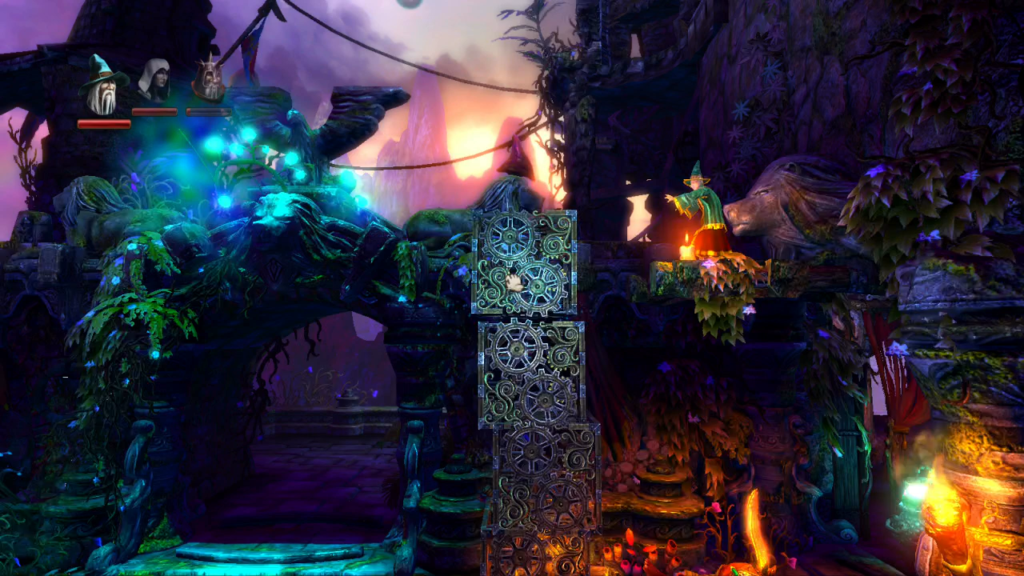
The trio do not begin their adventure with free access to all of their skills. At the outset, Pontius’ sword is plain and ordinary, Zoya’s arrows do not explode or freeze on impact, and Amadeus is limited to conjuring a single box at a time. To enhance their abilities, the trio must gather potions scattered across every level. There are hundreds in total to collect, and for every fifty I can choose to improve just one ability across all three player characters.
The difference between a level taking a half-hour or an hour to finish is how diligent I am in guiding the trio to all of these potions. Most are not hidden with guile. Many float in midair and must be reached by jumping up to them, often aided by Amadeus’ boxes and Zoya’s grappling hook. Others are contained in heavier bottles affected by physics. These offer the most variety in how they may be reached. A bottle on a high ledge can be climbed up to by stacking objects, can be pushed off with Amadeus’ levitation or a well-aimed arrow from Zoya, or sometimes even knocked down by destroying the object it rests on with an explosion.
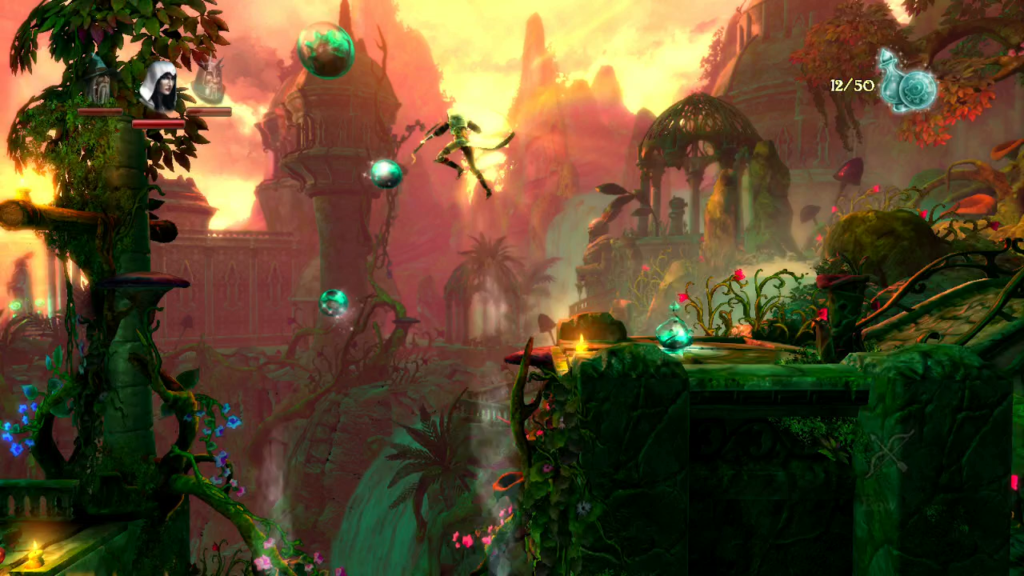
Since Trine and Trine 2 are broadly similar in their systems, many of the complaints I expressed about the trio’s specialized skillsets apply here as well. I only ever use Pontius in battle against goblins and the jungle’s other monsters. I only ever use Amadeus for platforming puzzles, or creating a tower of boxes to skip them. Zoya supposedly exists in a state between the other two, but I mostly take advantage of her grappling hook and rarely her combat skills. I would like to see the Trine series push the characters outside their obvious niches. Giving Pontius a role in platforming and Amadeus a role in combat would do much to add variety to the level design.
Pontius and Amadeus are given new unlockable skills intended to give them more utility outside their niches. Pontius learns to use his shield as a glider, and Amadeus can lock up monsters in cages. These additions are failures during my time with Trine 2. I only use Pontius’ shield floating when it is required and never use Amadeus’ magic cages at all. Zoya also gets an ultimate unlockable skill, an arrow that creates a magical circle of anti-gravity. I never find a use for it.
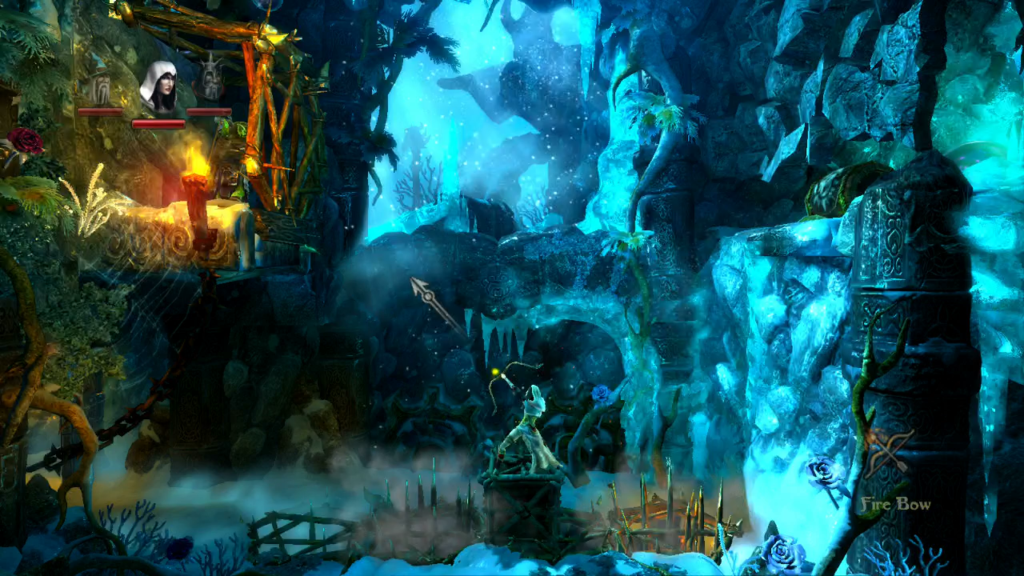
As I said of the first Trine, I would like to see more fundamental interaction between the trio’s individual skills. As it exists here, the greatest interaction between the trio is when Amadeus conjures a box and Pontius or Zoya jump on top of it. If their skills had more synergy it would make them feel like a team instead of like three individuals with three disparate skillsets amalgamated into a single form.
Most players who purchase Trine 2 on today’s storefronts will receive the Complete Story version. When they reach the end of the original story’s thirteen levels, they will be presented with seven more concerning a goblin invasion of a friendly kingdom and Amadeus’ kidnapped wife.
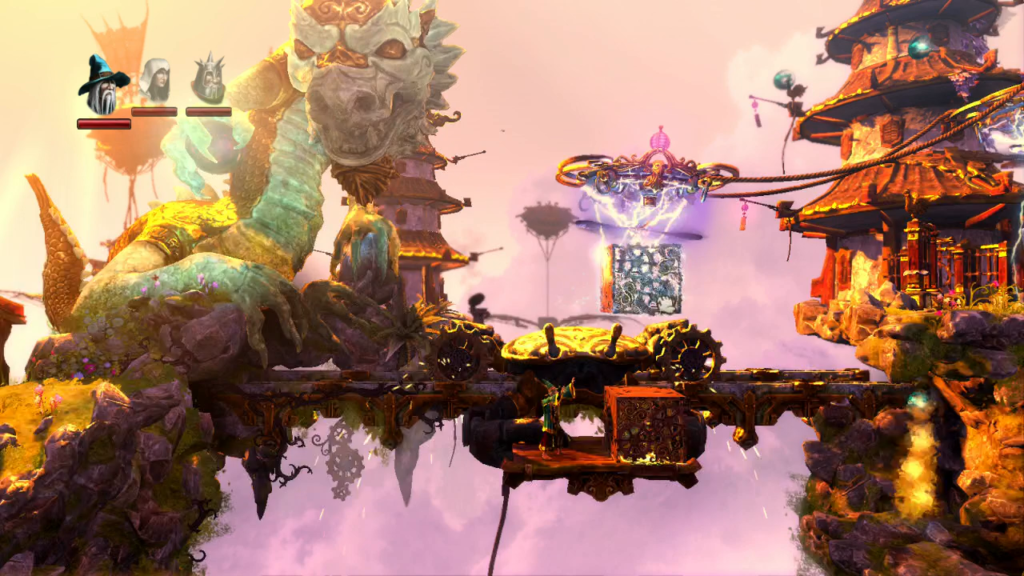
Immediately, the Complete Story levels feel like an improvement over the heroes’ previous adventures. The story is told with more cinematic effort, introducing most levels with cutscenes and following many puzzle-platforming solutions with sections that move with speed and explosive visuals. It is also Trine at its most ambitious. The overgrown jungle levels of the base videogame are lush, filled with dripping water and moody shadow, but there is little variety in these visuals for thirteen total levels. Complete Story sends the heroes from a besieged medieval village to a desert and cursed pyramid to a floating civilization powered by stormclouds. It’s an injection of much-needed diversity to the graphic and level design.
Despite these visual and thematic flourishes, the puzzles the heroes solve aren’t much different. They still involve the same box-stacking and button-pressing exploits. There are a few unique encounters. The trio are tasked with destroying a goblin siege tower by exploiting the physics that support it. Later, they must gather the parts to a flying machine and assemble them in a workshop. These are the exceptions and not the rule. By the time I’m finished with the original story and the Complete Story, my patience is tested.
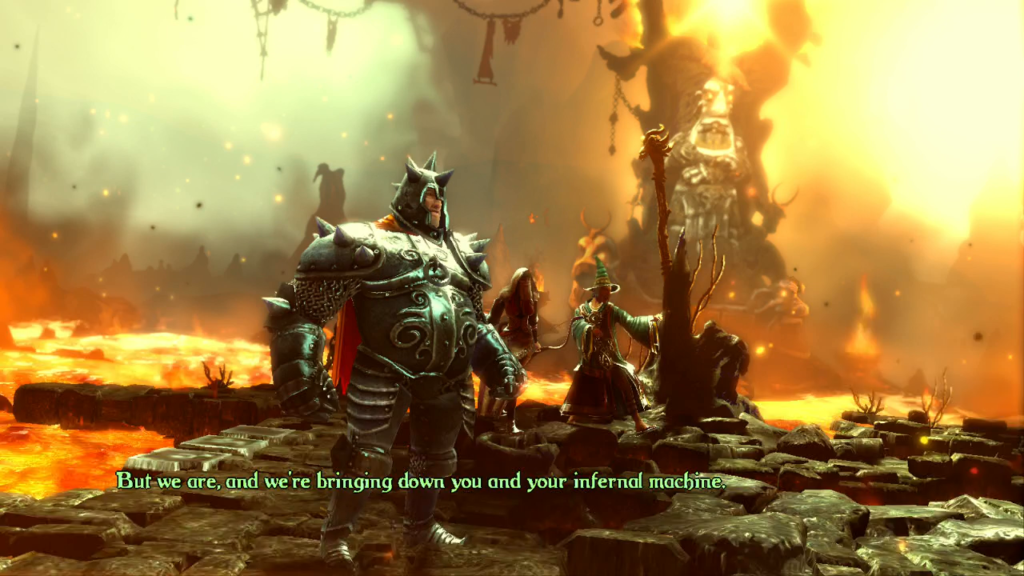
Trine 2’s biggest problem is it’s too much like the first Trine. This is especially true when that first Trine takes the form of its Enchanted Edition, which was updated to include many of Trine 2’s quality-of-life features. By the time I’ve played Trine Enchanted Edition’s fifteen levels, Trine 2’s original thirteen levels, and the Complete Story’s additional seven levels, I am exhausted by their quantity and frustrated by their uniformity. The series’ good ideas are stretched to their breaking point. Trine’s essential premise of using three unique player characters with magical powers to solve puzzle-platforming challenges is a good one, but the concept is exhausted between its first two installments. Future Trine videogames must make thoughtful changes to the series’ core design if they are to endure.